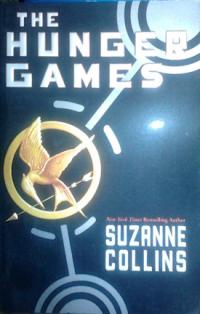The Hunger Games trilogy by Suzanne Collins has topped the children’s bestseller list for more than a year, a movie is now in the works, and Entertainment Weekly‘s recent spread on the casting clues the clueless that the brilliantly titled Games is poised to rush into the media void previously occupied by the likes of Twilight and Harry Potter. Plenty of adults are gobbling it down also, and recently I became one of them.
The Hunger Games is also the title of the first book in the sci fi trilogy (followed by Catching Fire and Mockingjay). It’s set in “Panem,” a nation carved out of what was once North America, ruled by evil, mostly unseen leaders from “the Capitol,” who keep its near-starving and terrified inhabitants in a state of submission– symbolized by the annual Hunger Games. The Capitol forces a boy and girl “tribute,” between the ages of 12 and 18, representing each of Panem’s twelve districts to fight each other until only one survives–the winner, who is feted and fawned on. The whole country is forced to watch the televised Games; a sinister Olympics, beautifully choreographed with ceremonies and special costumes.
When her gentle, 12-year-old sister, Primrose, is chosen, by a random draw, to represent District 12, Katniss Everdeen, 16, volunteers to take her place. A skilled archer and huntress, she appears to have as good or better a chance of anyone to survive the games, and since it is narrated in her voice, most readers probably assume that she indeed will. The suspense lies in how. Author Suzanne Collins does a yeoman’s job in depicting Katniss’s run-and-hide ordeal, fighting hunger, thirst, evil futuristic animals (“Muttuations”), and, above all, her fellow gladiators. A subtle romance between Katniss and fellow District 12 tribute Peeta evolves during quieter moments, complicated by Katniss’s feelings about Gale, the guy she left behind.
The book has undisputable cinematic oomph: silver parachutes descend with gifts from “sponsors; cannons blast when a “tribute” dies; the faces of the murdered kids are ghoulishly superimposed on the sky. Collins follows the time-tested dictum of end-of-the-chapter cliffhangers; just as we think Katniss’s travails are over, the second-to-last chapter’s breathless last line tells us: “And right now, the most dangerous part of the Hunger Games is about to begin.”
Collins has said the spark for TheHunger Games came when she was flipping channels and was disturbed by the contrast between a reality TV show and “a group of young people fighting an actual war.” She talks about wanting to open portals to let her presumably middle-class young readers about the trauma of lives marked by poverty and war. But there’s something disingenuous about Games. I turned the pages rapidly, wondering how Collins, via Katniss, would pull off the killings of 23 “tributes”–and still remain decent and likeable.
Collins largely evades this dilemma. Most of the kids kill each other off before Katniss must shoot a fatal arrow. As for the most riveting question–will Katniss be forced to kill her wanna-be-boyfriend, Peeta–Collins cleverly finds a way to defuse the dilemma. In so doing, she protects the innocence that, above all else, delineates the lines between adult and children’s literature.
Even more cleverly, she makes the romantic triangle–Katniss and two appealing guys–at least as intriguing as the fight to survive. I’m curious about the two successive books (in which Katniss and supporters battle the evil Capitol), but I suspect most of Games‘ young, female readers are not discussing her moral dilemma. Instead, they’ll be wondering: which of the two hot guys will Katniss end up with?


